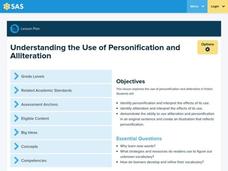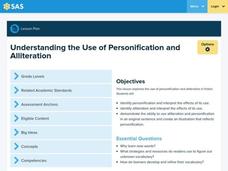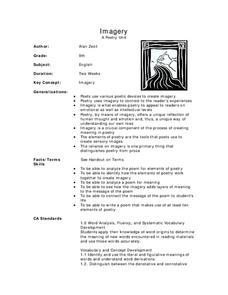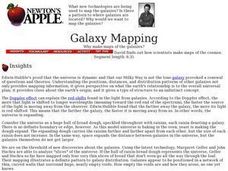Curated OER
Stylistic Devices
Students review connotation and denotation and stylistic devices in poetry. They read the lyrics to a song as it is being played and then discuss the meaning of the song. As a class, students read poems, share their thoughts, and...
Curated OER
Using Analogies to Improve Vocabulary
Ninth graders create and analyze analogies and infer word meanings from these relationships. Words can be taken from selection(s) or topics currently being read in class. These exercises strengthen student reading comprehension.
Curated OER
What Do You Call Older People?
Students brainstorm a list of words they use to refer to the elderly. As a class, they discuss the importance of word connotations and explain those used to refer to the older population. They complete a handout and share their thoughts...
Curated OER
It's Raining Idioms!
Sixth graders analyze idioms and find examples from literature. They choose one idiom and finds pictures or draws pictures to show what it would mean if taken literally and what is it generally thought to mean.
Curated OER
Newton and his Laws
High schoolers explore Newton's laws, including what they state, and what the intuitive meaning is of the first and third laws.
Curated OER
Analogies In Action
Students practice skills to determine the relationship of words. In groups of two, classmates complete a chart to match vocabulary words into specific groups such as synonyms, antonyms, or familial relationship. To reinforce word...
Texas Education Agency (TEA)
Geometry in Architecture #1
Discover how to analyze architecture from a geometric standpoint. The fourth installment of an 11-part unit on architecture first provides a presentation on axis, balance, basic form, formal, pattern, proportion, symmetry, and tripartite...
Texas Education Agency (TEA)
Byzantine Architecture
View Byzantine architecture from the comfort of your classroom. A PowerPoint presentation introduces important vocabulary terms and examples of Byzantine architecture in the ninth lesson plan of the 11-part series. A Jeopardy game...
Curated OER
Review of Literary Devices
Sixth graders review literary devices. They use both fiction and nonfiction texts to review metaphor, simile, alliteration, imagery, symbolism and personification. This lesson has a scripted guide for the teacher to follow.
Curated OER
Review of Personification and Alliteration
Learners review personification and alliteration. In this literary devices lesson, students use personification and alliteration in a sentence. Learners draw a picture reflecting personification.
Curated OER
Activity Plan 5-6: What's In a Name?
Students use family names to gather and analyze data. For this counting lesson, students use graph paper to help organize their data and then, in a staircase fashion, organize the names from longest to shortest so they can answer...
Curated OER
Changes in Latitudes, Changes in Attitudes
Sixth graders discuss how people, society, and technology change over time through a unit of integrated lessons. In these changes in society lessons, 6th graders discuss the answers to many questions about how changes effect the...
Curated OER
Elements of Poetry
Prepare your learners to identify figurative language in poetry. Tips for reading poetry and what to look for are listed on these slides. Rhetorical devices are defined and plenty of examples are given.
Curated OER
Reading Text with Appropriate Phrasing and Proper Expression
Practice reading with expression and appropriate phrasing with a scaffolded instructional activity. There is a detailed script here for you, but you could easily use it simply as an outline. Begin by modeling effective reading by...
Curated OER
Many Advantages of a Lesson Study
Collaborating with colleagues on the lesson-study process can enrich various areas of education.
Curated OER
Romantic Period in Music, Art, and Literature
“Romanticism aims at enlarging experience by exploring the real.” This excerpt from Jacques Barzun’s From Dawn to Decadence introduces a PowerPoint that examines the characteristics of and the major figures in music, art, and literature...
EngageNY
The Opposite of a Number
It's opposite day! The fourth installment of a 21-part module teaches scholars about opposites of integers and of zero. Number lines and real-world situations provide an entry point to this topic.
Curated OER
Drop it or not?
Students explore fractions. For this fraction lesson, students play an interactive game and use manipulatives to practice working with fractions.
Curated OER
Review of Personification and Alliteration
Young scholars study personification and alliteration in various fiction texts. In this literary devices lesson, students use various texts to identify the literary devices of personification and alliteration. Young scholars use examples...
Curated OER
Imagery
Ninth graders explore poems, various poetic devices, and identify imagery used in poetry. In groups, they examine poetic devices, define them, paraphrase and summarize poetry. Students study poetry by Robert Frost as they explore...
Curated OER
Poetry: Basic Elements of a Poem
People who pen poetry positively need to know basic tenets and terms of poetry, like alliteration and consonance, for example. These and other terms are define and illustrated. Then viewers are given an object and asked to craft a...
Curated OER
Galaxy Mapping
Students research the constellations and discuss their findings. Then they construct their own maps of the galaxy using paper, black paint, aluminum foil, etc. They make a 3-D map of their chosen constellation.
Curated OER
Kung Fu
In this Kung Fu activity, learners learn about the Chinese martial art called Kung Fu. They then answer the 10 questions in the packet. The answers are on the last page.
Curated OER
Nuclear Decay
In this nuclear decay activity, students read about alpha and beta decay and the isotopes formed by the reactions. Students solve nine problems including writing the equations for the decay of radioactive isotopes, identifying the...

























